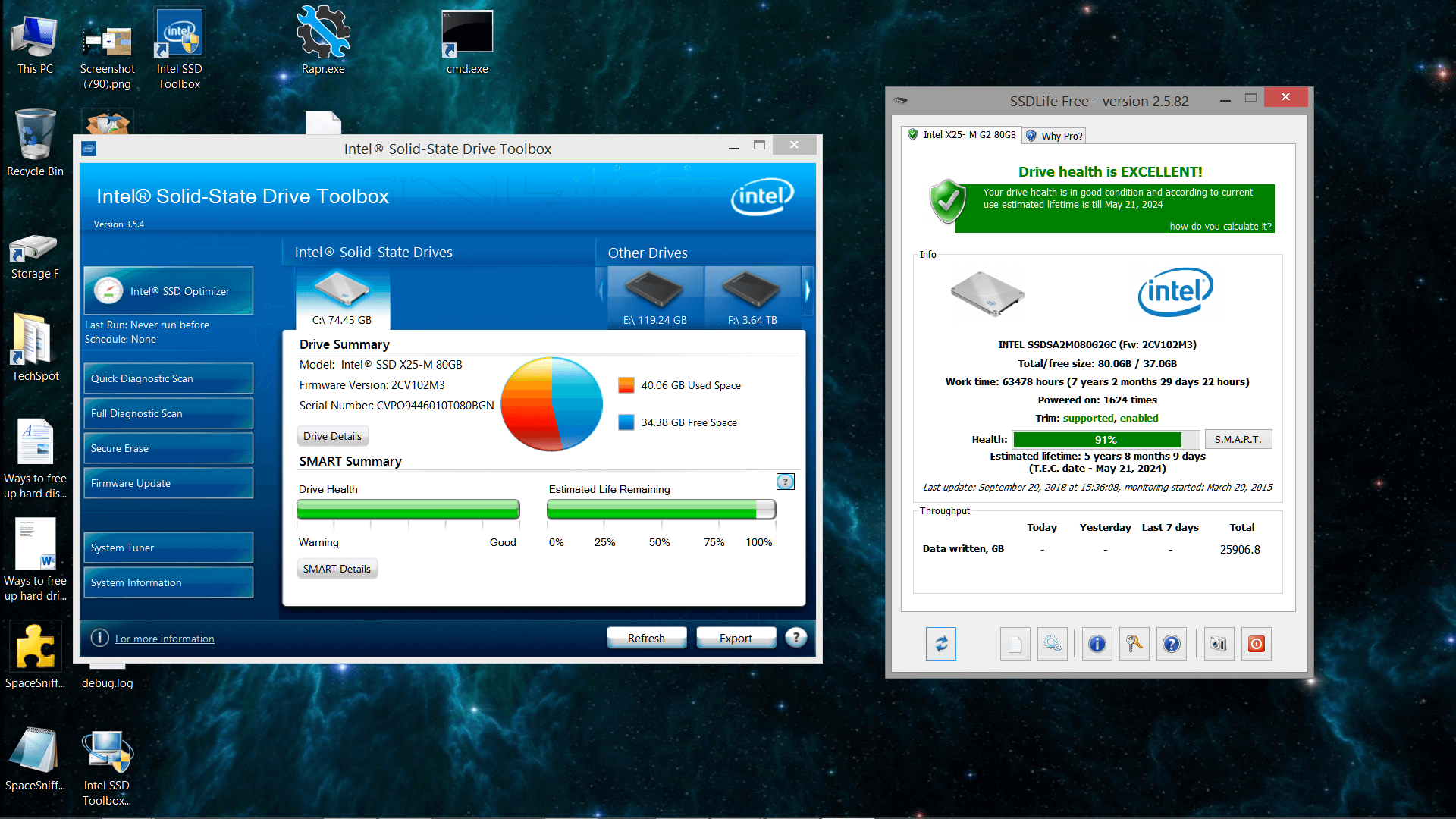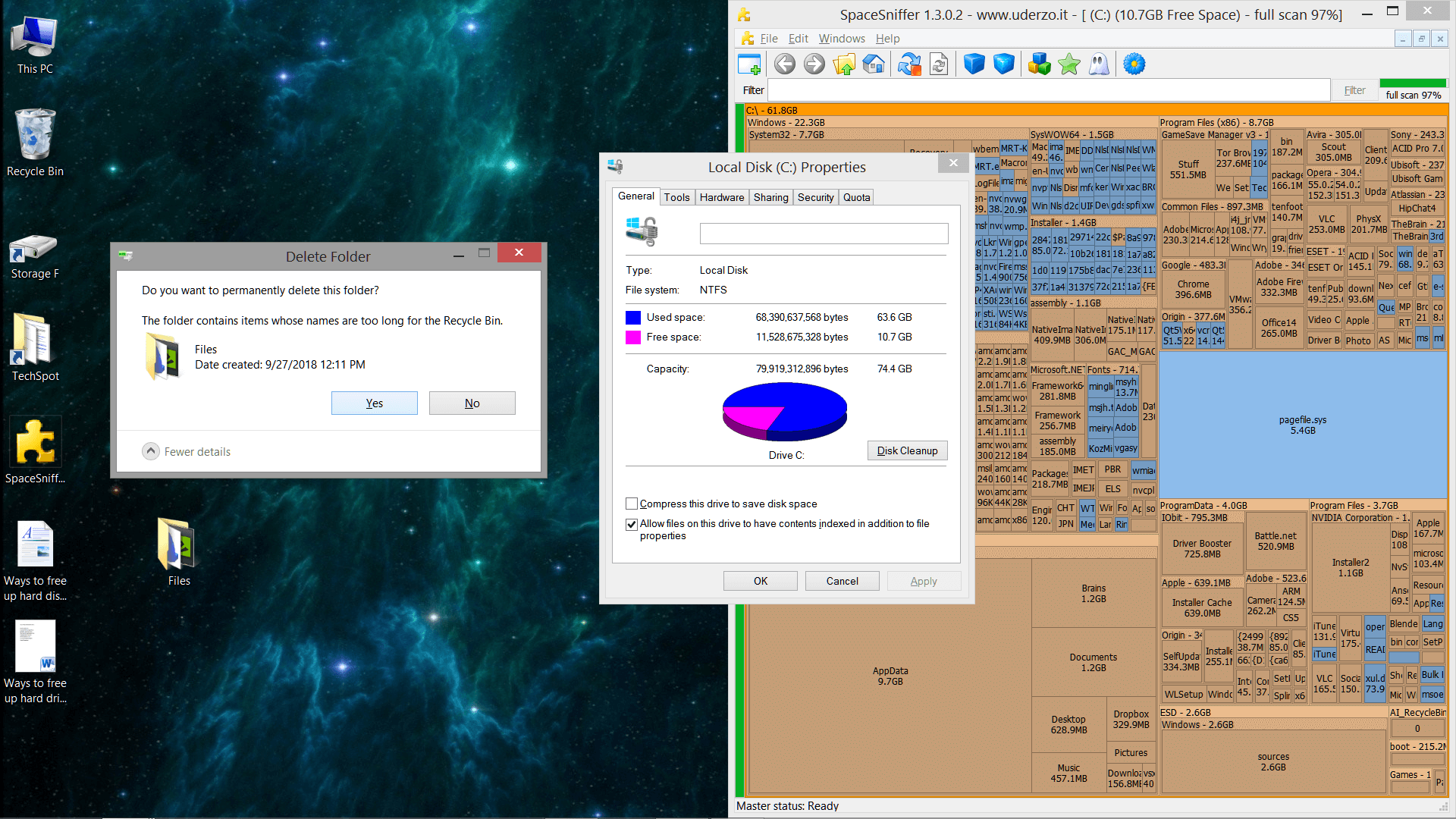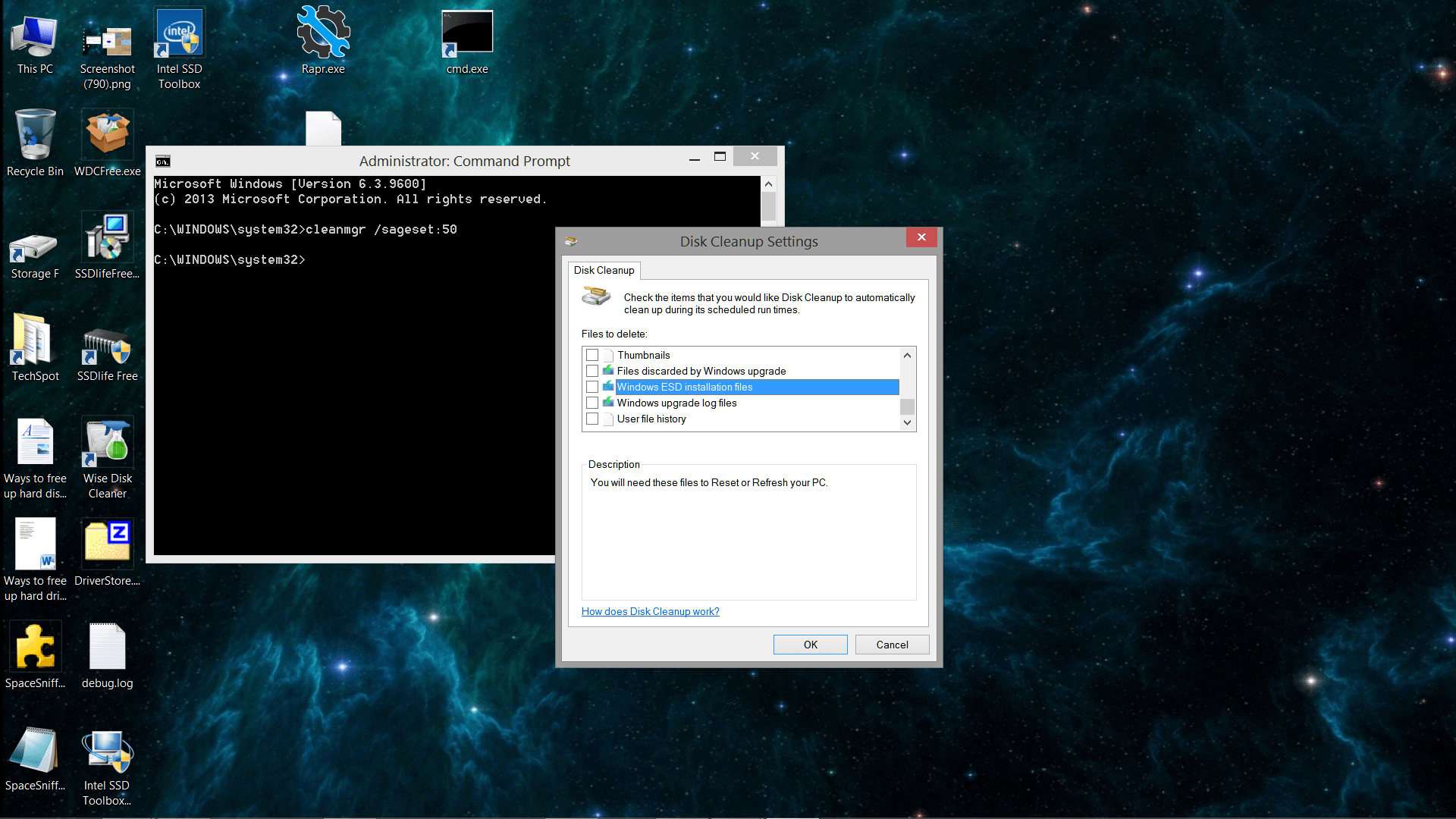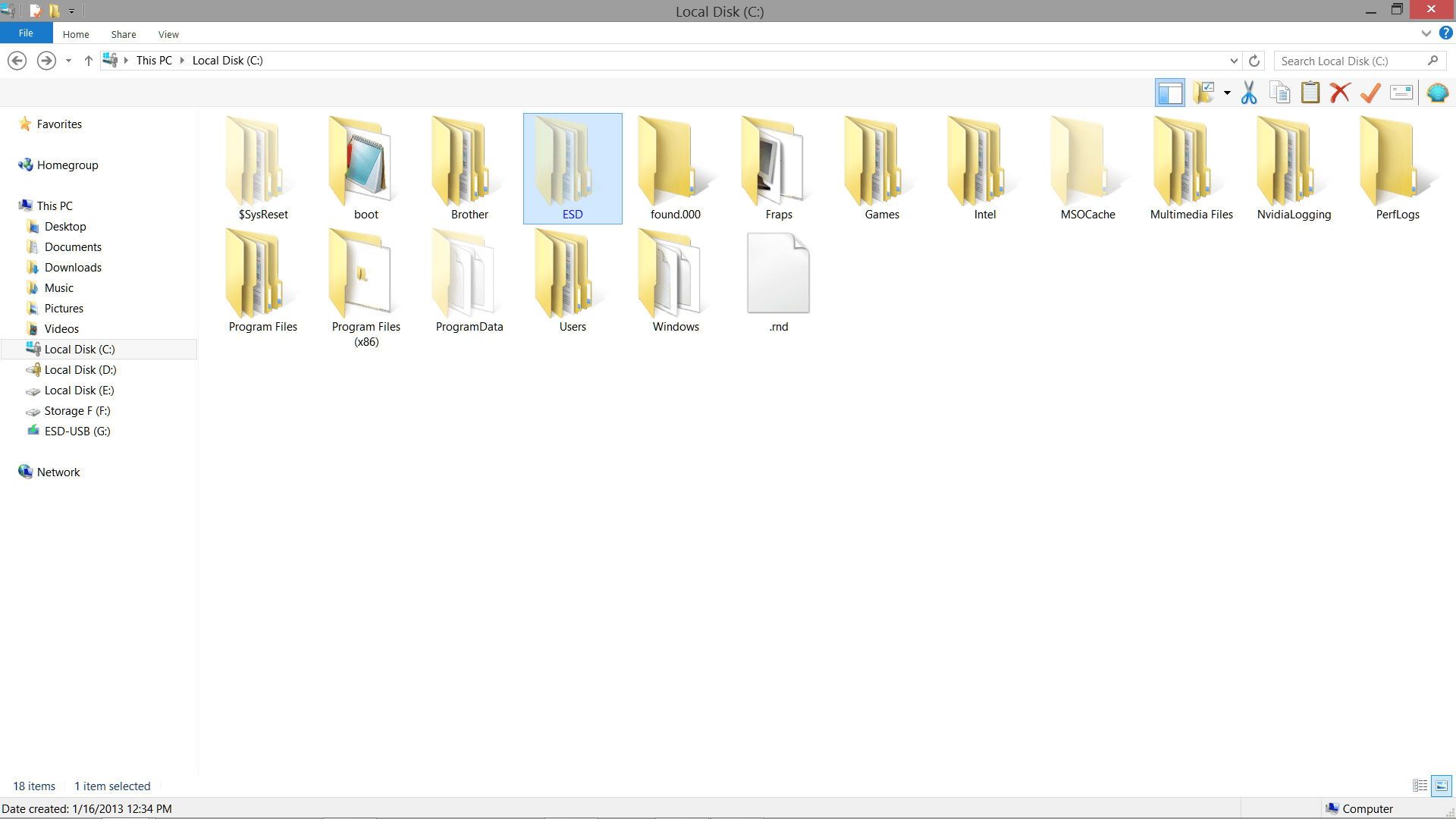Ways to Free Up Storage Space on Windows
Gigabytes are cheaper than always but they tin too exist the sort of thing where the more you have, the more you tend to consume, and it doesn't accept long for the terabytes to fly by if you spend a lot of time on your computer. Those of you running Windows on a meaty SSD probably know what a chore information technology can be to maintain plenty space on your drive between mobile backups, Windows Updates, PC games, media files, and then on.
For this little guide we took it to an extreme past trying to costless up space on an old 80GB Intel X25-Thou G2 solid state drive. Although SSDs have improved by leaps and bounds over the nine years since this Intel drive was released, the device still has plenty of life left co-ordinate to SSDlife Free and Intel'south SSD Toolbox utility.
Spending a mere $50 for a 250GB Samsung 860 Evo bulldoze that is 200% faster than this old drive volition eventually be a wise investment, only to be honest apart from oft running out of storage, we oasis't had a reason to upgrade the drive, nor accept we installed a new copy of Windows in more than than five years. If you're wanting to clean upward your drive, this guide will serve you lot regardless of your current storage solution.

After hovering effectually <10GB for too long (enough to download or transfer a large file), nosotros set out to regain as much infinite every bit we could past moving, compressing and deleting files from all around Windows. In the end, 27GB of storage was recovered (37GB total gratuitous) and we took notes along the mode to share with you in the upshot that your Windows drive is as well low on space.

Options are organized from to the lowest degree to most extreme...
Scan for files with Disk Cleanup, and 3rd party tools
Junk file cleaners make information technology easy to perform a system-wide file cleanup and may be useful for freeing upwardly storage on depression chapters SSDs where a few extra gigs can brand or break the functioning of your operating system. If you've never used a junk file remover earlier, yous might exist surprised past how much space tin can be reclaimed with even Windows' own built-in Disk Cleaner:
- Search the Start Menu for Disk Cleanup
- Open Disk Cleanup and select your principal organisation drive
- The tool will scan your drive for unnecessary files and erstwhile cached data
- Clicking "Make clean upwardly organization files" nearly the bottom of the window will run a second browse
The issue of the scan volition display different types of data, from Recycle Bin files to temporary net cache. If you clicked Clean up system files, "Temporary Windows installation files" amid other Windows files volition be listed, which could easily be consuming several gigabytes to as much equally 25GB or more.
Disk Cleaner can besides be launched with advanced options such as the ability to delete files that would be used to reset your operating system (the Windows ESD files) past copying or entering this line into a Command Prompt: cleanmgr /sageset:50

We waited until after manually cleaning everything we could earlier running Disk Cleanup and the tool only freed 200MB of space, though nosotros've also scanned with the software recently.
Subsequently Disk Cleanup, we tested with Wise Deejay Cleaner (our recommended CCleaner alternative) and recovered another 2GB+ between the mutual and avant-garde cleaners.
Enable Windows 10 Storage Sense
Windows 10 has an automated disk cleaning service that you tin enable in Settings > System > Storage > "Turn on Storage sense." The feature auto-scans for temporary files when you lot're low on deejay infinite along with removing local copies of OneDrive files and making them online-only after not beingness used for 30 days.
Y'all can perform that scan manually by clicking "Free up infinite now" on the Storage Sense settings page and the utility will delete the post-obit data:
- Temporary setup files
- Old indexed content
- Arrangement cache files
- Internet cache files
- Device Driver packages
- Arrangement downloaded program files
- Dated organisation log files
- Arrangement error retention dump files
- System fault minidump files
- Temporary system files
- Dated Windows update temporary files
Manually search for files you lot no longer need
Deleting duplicate files from your organisation could recover many gigs of space if just a few large files are found. Unfortunately, without PowerShell scripts or searching for the files via File Explorer, Windows doesn't make it like shooting fish in a barrel to find duplicate files. Nosotros recently tested third-party software dedicated to deleting duplicate information and constitute CloneSpy to have the best combination of providing just enough features with a ataxia-free interface.
You may also want to download a deejay space analyzer such equally SpaceSniffer, which will scan your bulldoze(s) and display all of the files in an interface that makes it easy to see what's occupying the nearly storage.
Download: SpaceSniffer | Xinorbis | WinDirStat | SequoiaView | TreeSize Free
The Windows User AppData folder (C:\Users\username\AppData\) is a practiced starting point for finding big amounts of application files for browsers, messengers, game clients and more, including a temp folder that independent 606MB of data on our system.

Places you might be able to regain some storage space:
- Mobile backups of your phone or tablet (Apple software occupied a lot of space)
- Files for unused spider web browsers, instant messengers and game clients
- Old Bone bulldoze images and other fill-in files
- Emails stored locally (especially attachments)
- File conversion software with media files stored in random locations (saved 710MB from an FlvtoConverter folder)
- Deject storage software with files stored locally that you can remove (we had 1GB+ of sometime Dropbox files)
- Tools that auto-update your drivers (Driver Booster and Driver Max occupied well over a gig!)
- Unused virtual machines (nosotros sometimes accidentally create VMs on C: instead of another drive)
- Temp folders everywhere (search for them via File Explorer i of the analyzer apps)
Motility media files and software to another bulldoze
Similar scanning for junk files with Disk Cleanup or CCleaner, moving large video and other such files to a secondary storage device is somewhat of a given, just we're starting with the least extreme options.
Moving Steam games to another drive or partition is a piffling more involved than copying a unmarried file or folder and although tertiary-party software used to be required for the process, Steam at present provides the ability to store games on multiple drives:
Navigate to: Steam > Settings > Downloads > Steam Library Folders and brand a new Steam library folder on the new drive, and so right click on an already installed game in your Steam library and go to Backdrop > Local Files tab > Motility install folder... > Choose the directory > Motion folder.

You can too motion other files to another drive and create a shortcut or a symbolic link to them, such as the ESD folder that we discuss later which contains a few gigs worth of files used for resetting Windows to its default state.
The Windows control mklink links one directory to another so that when software interacts with location A, it's redirected to location B. In the example of a PC game, Steam would think the game was in its original directory, but the files would instead run from a different drive. Here'due south a quick start guide for using mklink and some third-party software that lets you create links from a GUI instead of a control line:
- Create the binder where yous'd like your new files to be
- Cut and paste the files from the former location to the new binder (don't leave the files behind)
- When the transfer finishes, open the Control Prompt and enter your mklink command (like this):
mklink /d "c:\files" "d:\files"
Command options for mklink:
/D Creates a directory symbolic link. Default is a file symbolic link
/H Creates a hard link instead of a symbolic link
/J Creates a Directory Junction
Link Specifies the new symbolic link name
Target Specifies the path (relative or absolute) that the new link refers to.
Clean unused system and driver files
Not long dorsum nosotros discussed methods for reclaiming several gigs on your storage drive by deleting the Windows.former backup folder that'southward created when reinstalling or upgrading Windows. The binder contains all the files from a previous Windows installation and can exist deleted if you no longer need the data (or the folder can exist moved to another drive).

You can also salve infinite on files and folders without deleting them by enabling Windows' congenital-in compression option: Right-click an item, go to Properties, click the Advanced push and check the box next to "Compress contents to save disk infinite" -- click Ok twice to ostend/get out. Compressed files and folders will accept bluish text. Side note: Compression is undesirable for any system file or files that volition be accessed even sporadically. Only use for archiving purposes.
Out of curiosity, nosotros deleted a Windows account that was mostly new and unused to see how much storage would be freed and this didn't even recover 0.1GB but might be worthwhile for erstwhile accounts with a lot of data. Navigate to C:\Users, right-click the user folder for the account y'all desire removed and delete it.
Nosotros also cleaned many other system and driver files from diverse locations effectually Windows 8.ane with results that ultimately reclaimed more than than iv.5GB on our SSD, and that could have been well over 7GB if we deleted the ESD folder discussed in a moment.
Organisation and driver files we tried to make clean...
C:\Windows\System32\DriverStore\ - Occupied four.3GB
Windows stores its installed drivers in the operating system's "DriverStore\FileRepository" folder, which tin become chaotic with old driver files over time, especially for hardware such as graphics cards that recieve regular software updates.
We tried Command Prompt methods to automatically batch clean the DriverStore folder of all the drivers files not being used past Windows, just none of the commands worked except Microsoft'due south instructions for manually deleting them ane by 1. Fortunately, there's a 3rd-political party utility that lets yous browse and delete unused driver files in the DriverStore

Commuter Store Explorer loads all the cached drivers which yous can filter by device type, manufacturer, commuter version and even the size of the file, making it easy to detect large drivers worth deleting. There'southward fifty-fifty a "Select Onetime Driver" button that will auto-check the boxes next to unused driver files, which can exist deleted all at one time.
Cleaning the DriverStore FileRepository binder with Driver Shop Explorer released 2.6GB of space, most of which was Nvidia drivers...
C:\Windows\WinSxS - Occupied 7.56GB
WinSxS is the location for Windows Component Store files, which are used "to support the functions needed for the customization and updating of Windows," including operating system functions such equally Windows Update installing new component versions, uninstalling a corrupt update every bit well every bit other system recovery operations. Microsoft has instructions for cleaning the unused components in this binder, which involves entering a command or ii in an administrator Control Prompt.
The visitor says that the following command volition remove previous versions of updated components, but when we tried this, the performance gradually occupied around a gig of space then released that gig afterward completing without freeing up much if whatsoever infinite.
/online /Cleanup-Image /StartComponentCleanup

All the same, adding /resetbase to the end of that line (so, /online /Cleanup-Image /StartComponentCleanup /resetbase ) will remove "all superseded versions of every component in the component store" and this managed to reduce the size of our WinSxS folder past nearly 2GB from vii.56GB to 5.98GB.
C:\ESD - Occupied two.68GB
Microsoft recommends against deleting this folder considering it'due south "used past Push Button Reset feature to reset your figurer back to its original install country," in other words, files used for resetting Windows. That said, the binder can technically exist deleted if you don't plan to utilise this feature or take already made an external USB recovery drive (search Start for Create a recovery drive) which will provide the same functionality.
Note that secondary system files scan in Disk Cleanup in Windows 10 may include the ESD binder as an pick for deletion. We're doing the cleanup on Windows viii.ane, but ESD can still exist included with the instructions in the Disk Cleanup section above.
If you can't see the folder while browsing C:\ in the Windows File Explorer, get to View and check the box that enables "Subconscious items."
Our auto did not demand the extra space desperately enough to delete the ESD folder.

C:\Windows\Installer - Occupied one.1GB
This directory serves as a enshroud location for Windows installer based applications along with "stripped down versions of the Windows installer information files," co-ordinate to Microsoft.
During application install, update of the application or awarding removal, this directory is used by the application to ostend the existence of previously installed items to determine the next steps the installer needs to have.
The company suggests that simply uninstalling a given application is the all-time way to make clean its associated files from this folder.
C:\Program Files\Nvidia Corporation\Installer2 - Occupied 1.1GB
This location contains installation files from previous iterations of Nvidia'south drivers and the company's web page about this folder says the contents of this folder can be deleted without affecting your currently installed drivers or software. "At near, information technology volition prevent complete installs from occurring in the case of using an older driver from the Os driver store." We deleted all of the files in Installer2.

C:\Users\username\AppData\Local\Nvidia\NvBackend{ABAF8EFC}\ - Occupied ~1GB
Nvidia's "NvBackend" folder took up nearly a gig, 830MB of which was in "Packages" and on our system this included 114 executable files named "DAO.insertrandomnumber.exe" that occupied 512MB of space. Afterwards much searching we couldn't determine if these files were safe to delete.
Proceed at your own take a chance...
Reduce Windows Organisation Restore, hibernation & pagefile
These are the most farthermost methods for recouping disk space on a Windows installation. While non recommended prior to trying the previously listed options, many gigabytes tin can be salvaged past making some advanced system tweaks.
Adjust your System Restore settings
Introduced with Windows ME, System Restore creates automated backup files that tin return your system, settings, programs and Windows Registry to a previous state. Depending on the size of your drive and the capacity percentage that System Restore is set to occupy, y'all may be able to reclaim several gigs by reducing the corporeality of storage it can utilize, deleting old restore points or disabling the feature altogether. To go started:
- Search Commencement or Run for sysdm.cpl
- Get to the Organization Protection tab
- Select your Windows drive and click Configure...
The window that opens will accept a slider that you can suit to modify the maximum deejay space that Organization Restore is allowed to consume on your drive -- the less space y'all define, the more ofttimes erstwhile restore points will be deleted. You tin besides manually delete old restore points or disable the feature from the aforementioned window.

Restore points tin be upwards of a gigabyte so somewhere around 2GB is probably the minimum y'all'd want in most situations, although we've been using one.49GB (ii% of our drive) for years with no issues. This seems to provide plenty space for at least one restore point, which has spared us the trouble of reinstalling Windows once over the years.
Delete hiberfil.sys, disabling Windows hibernation
Hibernation writes your current system country to a non-volatile retentiveness source such as your principal HDD or SSD, allowing you to turn off your organisation and restore your progress at a later engagement.
Turning on a system from hibernation is generally faster than starting from a cold boot and it doesn't require a abiding power source like sleep, which stores data in RAM.
That said, if your operating system is on an SSD, load times should be sufficient and desktops are normally connected to a power source anyway, then using sleep instead is typcically fine.
Your hibernation file (hiberfil.sys) is probably occupying a few gigs to a dozen or more and the file tin can be purged from an elevated Control Prompt:
- Search Kickoff or Run for cmd.exe
- Correct-click on cmd.exe and choose Run as administrator
- Enter the following command: powercfg.exe -h off

We already had hibernation disabled merely re-enabling the feature consumed 12.8GB on our SSD.
Reduce or relocate your Windows page file
While not encouraged, you may be able to shrink or disable your page file (pagefile.sys), which allows Windows to utilise some of your bulldoze space as arrangement memory. The operating organization can move infrequently used information from your RAM to the page file on your bulldoze and the feature is peculiarly useful if you are running low on organization memory.
Past default, the Windows folio file is configured to occupy many gigabytes on your arrangement bulldoze (iii x RAM or 4GB, whichever is larger) only if you have plenty of RAM or are confident that your system'due south performance won't be affected past reducing the size of your pagefile, the feature can be tweaked past navigating through these menus:
- Search First or Run for sysdm.cpl (or right click This PC > Properties > Advanced system settings)
- Select the Advanced tab and so open Performance Settings
- Become to the Advanced tab (once again) and click the Change button under Virtual retentivity

From the Virtual Memory window, uncheck the box for automatically managing your folio file sizes, select your drive from the list and define a new custom size for the page file. Note that you can also move the page file to another drive from the same window...
- Select the drive with the page file from the list
- Click No paging file and so Gear up to disable the folio file on this drive
- Select some other drive and cull Custom size or Organization managed size to enable the page file elsewhere
As for how large your page file should exist, Microsoft'south definitive guide on the field of study says there's no value that will work for every machine. However, the visitor suggests that adding some performance counters to the Windows Functioning Monitor (perfmon.exe) volition provide information which can be used as a baseline to determine the best page file size for your system. We reduced our page file from 5360MB to 4000MB.
A quick highlight reel of our drive cleanup
To recap, we've included some of the ways that we regained the 27GB on our Windows drive. This isn't a crook canvas for the article because there are more methods higher up for cleaning your drive than nosotros actually used, but we thought a play-by-play of our clean-out might exist useful to someone in a similar situation.
Hither'due south most of what nosotros did:
- No longer use an Apple device, deleted everything Apple tree (including iTunes and Safari, mobile backups etc.) Had to manually delete 457MB worth of files at C:\Users\TechSpot\Music\iTunes and some other 500MB of Apple information from C:\ProgramData. (+1.6GB storage space)
- Uninstalled other onetime unused software from Windows' built-in Add together or remove programs utility. (+three.9GB)
- Manually deleting program files found via SpaceSniffer (Avira Picket for example wasn't listed in add/remove programs along with other leftover files from uninstalled applications, not to mention a random VLC stream file and 710MB of files in an FlvtoConverter folder) (+many many gigs)
- Deleting the contents of this folder recovered several more gigs worth of storage: C:\Users\TechSpot\AppData\Local\Temp
- Scanned with Disk Cleanup -- basic and advanced (+200MB)
- Scanned with Wise Deejay Cleaner (+2.2GB)
- Deleted the contents of C:\Program Files\Nvidia Corporation\Installer2 (+1.1GB)
- Cleaned DriverStore folder with Driver Store Explorer (+2.42GB)
- Cleaned WinSxS folder via Command Prompt (+one.58GB)
- Compressed diverse folder effectually the operating system
- Reduced page file from 5360MB to 4000MB (+1.3GB)
- (Already had hibernation disabled and System Restore minimized)
- Final scans with Wise + a organisation reboot resulted in 37GB of gratuitous drive infinite, up from x.5GB at the starting time of cleaning.
More Useful Tips
- Refresh Windows 10 to its default state in a few clicks, keeping your files and settings
- What Are the Best CCleaner Alternatives?
- How to Recover Data From a Corrupt ZIP File
- 12 Windows Clipboard Managers Tested
Masthead epitome credit: Cleaning an open computer hard drive by Amy Walters
Source: https://www.techspot.com/guides/1715-free-up-storage-space/
Posted by: augustinefirig1984.blogspot.com


0 Response to "Ways to Free Up Storage Space on Windows"
Post a Comment